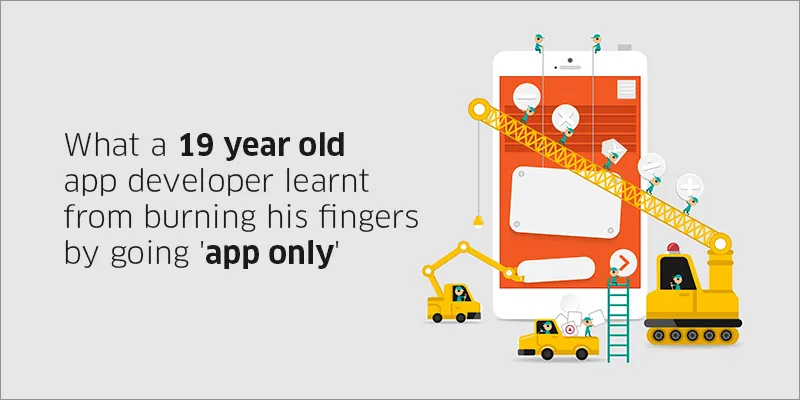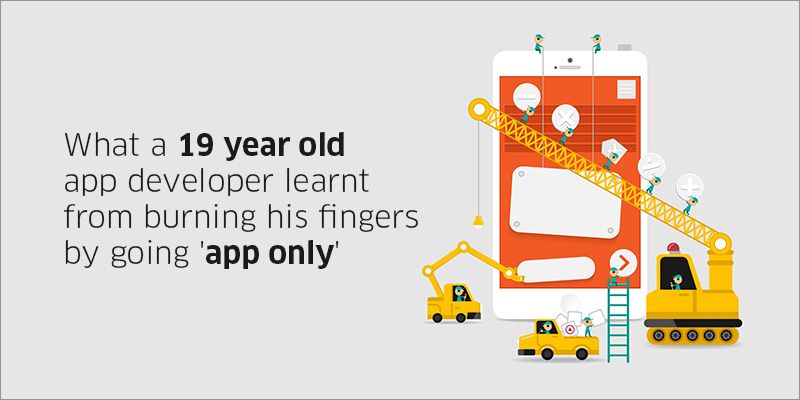What a 19-year-old app developer learnt from burning his fingers by going ‘app only’
With global mobile sales growing exponentially, a lot of developers want to get involved in the mobile app market. Smartphones and tablets are a powerful medium, no doubt, with everyone from kids to grandparents using them. These are exciting times and many are going mobile-first in a mad frenzy.

A young first-time entrepreneur in his early twenties told me that he was going app only. I wanted to give him some feedback based on my own bad experiences but then thought better of it. As I had expected, his app went quickly as it had come. I’ve noticed in many events people talk about their mobile app strategy. These are generally people in the startup ecosystem that have themselves gone app-only or have invested in app-only startups. I tried going app-only too and found that it is not as glamorous as people often describe it to be. Here are some things I’ve learned:
The app ecosystem is not a level playing field
Forget ‘me too’ apps; the rules of the game are different on various app stores. You are actually competing with other apps despite not being in the same area of relevance. I learnt this the hard way. The problem is that a lot of Original Electronics Manufacturers(OEMs) bundle a few apps of their own and ship their smartphones.
For higher-end smartphones with storage space of 16GB and above, this may not be much of a problem but a vast majority of the population in emerging markets are on low-end smartphones in the below Rs 10,000 range. Installing more than 10 apps on such smartphones is an issue because of limited space, pre-installed apps and other bloatware. So as an app developer you are indirectly competing with popular apps such as Whatsapp, Facebook, Twitter and Candy Crush.
Access to latest technology and using them are two different things!
A recent ad of a smartphone maker ridicules people using 3G saying ‘3G is history, Dad!’ Well, after you ship your Android application package (APK) to the Google Playstore you will realise that 4G is a mystery. I went around requesting data from a few leading app developers and to my surprise found that most of their users were on 2G networks.
3G usage is jumping for sure but still shipping an optimised version of your APK that doesn't eat a lot of your users’ data pack is the surest way to increase your downloads. So it’s always better if you end up coding your app natively rather than going with hybrid approach. The former strategy results in nearly 2X more compression on top of better performance.
Native vs hybrid apps
Another benefit of using native apps is the robustness, durability and better performance compared to hybrid apps. There is a popular misconception that as tech guys, we have a knack for coding several cool sounding features but never completing them! Whether we do it or not, it’s generally best practice to ship only the features that work fully to avoid bloat as well as getting good reviews from users. Using lots of Software Developer Kits, underpowered backend and high latency can kill you quickly.
‘Design’ means different things to different people
Most people are under the impression that app developers don’t care about design. But design means different things to different people. It is not just how the app looks but also how it works. The reason why Google released Material Design was because they wanted to solve a problem as old as Android itself: familiarity. Users need to relearn where to go and what to do, which will probably reduce user retention straight away. Using a set of elements that are common across all the apps goes a long way in terms of ease of access and retention. Apps with Material Design look good too which is an added bonus.
Growth rate doesn’t equal number of installs
Tracking number of installs may not be the most optimal way to measure your users. Your markets will perhaps tell you of the thousands of installs daily but your developers will be the ones working on bringing down the uninstall rate. You may have more uninstalls than installs owing to a lot of reasons which are typically a subset of the reasons written above. So you will be left with a very small user base and even lesser active users (This varies from case to case).
Advertising is very competitive too!
Irrespective of whether your app gets a hockey-stick-like growth or not, the cost of advertising is going up in that fashion. Web apps and web ads have a simple model: advertise for new users and re-market once or twice and you have them (at least 75 per cent of them convert). But coming to mobile apps, people uninstall your app, reinstall it again and the process goes on an on. So think twice if you are bootstrapped, as nearly 90 per cent of the money will be burnt up in the process.
Fragmentation
So your developer wrote neat code for the latest version of Android (iOS or even Windows Phone) and a user installs it and your app explodes in his hands. Sometimes all these silly things cost you dearly. And half of the features that were written with X.YZ version of the Operating System and above in mind don't really work well below it, so you have to take a tough call. To support or not to support a feature: OS is the question.
Generating revenues
Even if you do survive till here, this will most likely kill you. Robert Scoble has always been bullish on iOS because its users are more likely to pay up for apps compared to Android users. Most app developers work on the freemium model with in-app purchases or generate revenue from ads as getting people to buy apps upfront is difficult. Generating revenues on these platforms is so hard that they are giving MBAs a run for their money.
App store optimisation, negative comments, scaling woes, feature requests
And if all the above problems were not enough, app store optimisation(ASO), negative user ratings and specific feature requests from users are additional things that you need to keep track of to improve discoverability and traction of your apps. Out of 10 comments you receive for your MVP, four perhaps will be negative ones. Your backend needs to keep up with the artificial growth that you are trying to produce with a few features that are either loved by a few or hated by all.
Finally, what doesn't kill you makes you stronger! It is certainly glamorous when you end up as the ‘app of the day’ or ‘top most paid app’ in the Playstore and you look back and see it has all been worth it.
About the author

Harsha Halvi is the Co-founder at Contactz, an app that allows users to sync, store and share contacts across different devices. He juggles technology to make things that people want.
Related read: ‘Average device in India is only 10 months old!’ What does the data of 8M mobile app users in India indicate









